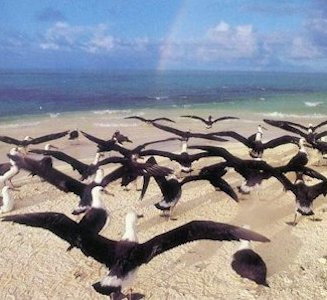
|
Aerodynamics of Bird Flight The dominant aerodynamic forces that affect flight are lift and drag. The difference in the pressure of air above and below a wing produces lift. When a bird holds its wing at a sight angle to an air current, air flows faster over the upper surface than it does over the lower surface, thus creating less pressure above the wing than below it and causing lift. At the same time, drag, or resistance to the moving air, drags the wing backward. the combined effect of these two forces lifts the wing and drags it backward. While most of the lift on a bird's wing comes from the low air pressure on its top, a certain amount of lift is generated from beneath by air striking the undersurface of the wing. Air flow in the under side stops at a point close to the wing's front, or and then gradually speeds up until it is near the back, or trailing edge, by which time it has reached the same velocity as the air traveling over its upper surface. If the front edge of the wing is tilted upward just a little bit and is placed in the air stream, the air will strike the bottom surface more directly, thereby increasing the lifting force on the wing from below. The more the wing is tilted upward, the more lift it will get, but only to a certain point: When the angle of tilt approaches the vertical, the air pressure against the bottom surface begins to push the wing backward rather than upward. If the wing is tilted too much, the lifting force eventually vanishes and the drag is so great that it stops the bird's "buoyancy," or forward movement. This results in what is commonly called a stall, and the bird must regain the proper wing angle and flight speed or it will crash. Click here for a Lift Diagram |
|
| Spreading their wings into the wind, these young Laysan Albatrosses learn about the fundamentals of lift and drag. By manipulating these forces, the birds achieve optimum endurance and agility in the air. | ||